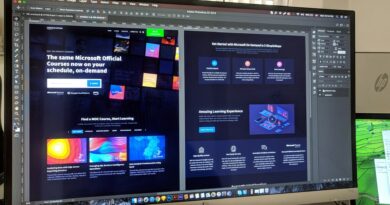Trends in Web Design for 2025
When we think about the evolution of web design, we often marvel at how far we’ve come in just a few short years. From the early days of static HTML pages to the interactive, dynamic websites we see today, the world of web design is constantly evolving. As we look ahead to the year 2024, it’s fascinating to consider what new trends and innovations will shape the way we experience the internet. In this article, we’ll explore some of the key trends in web design that are expected to dominate the digital landscape in 2024. Join us on this journey into the future of web design!
The Rise of Immersive Experiences
One of the most exciting trends in web design for 2024 is the continued rise of immersive experiences. With advancements in technology such as virtual reality (VR) and augmented reality (AR), designers are now able to create websites that truly transport users to another world. Imagine being able to explore a virtual showroom for a furniture store, or take a virtual tour of a hotel before booking a room. These immersive experiences not only engage users on a deeper level but also help businesses create memorable online experiences that set them apart from the competition.
Companies like IKEA have already started to experiment with VR and AR technology on their websites, allowing customers to visualize how furniture will look in their own homes before making a purchase. As this technology becomes more accessible and affordable, we can expect to see more and more websites incorporating immersive experiences into their design.
Minimalism and Simplicity
While immersive experiences are on the rise, we’re also seeing a trend towards minimalism and simplicity in web design for 2024. In a world where we’re constantly bombarded with information and stimuli, users are craving clean, uncluttered websites that allow them to focus on what’s important. Minimalist design not only looks sleek and modern but also helps to improve user experience by making information easier to find and digest.
Many companies are opting for minimalist designs that feature plenty of white space, simple typography, and a limited color palette. This allows the content to take center stage and ensures that users can quickly find what they’re looking for without being overwhelmed by unnecessary elements. In 2024, we can expect to see even more websites embracing this back-to-basics approach to design.
Personalization and Customization
Another key trend in web design for 2024 is the emphasis on personalization and customization. With the wealth of data that companies have access to, it’s easier than ever to create tailored online experiences that cater to the individual preferences and needs of each user. From personalized product recommendations to custom landing pages based on a user’s location or browsing history, websites are becoming increasingly adept at delivering content that is relevant and engaging.
Personalization not only enhances the user experience but also helps businesses drive conversions and build customer loyalty. By showing users content that is tailored to their interests, companies can increase engagement and encourage repeat visits. In 2024, we can expect to see more websites leveraging data-driven personalization techniques to create truly unique online experiences for their users.
Accessibility and Inclusivity
As we move into 2024, there is a growing awareness of the importance of accessibility and inclusivity in web design. Designing websites that are accessible to all users, regardless of their abilities or disabilities, has become a top priority for many companies. From providing alt text for images to ensuring proper color contrast for text, designers are taking steps to make their websites more inclusive and user-friendly for everyone.

By AS Photography via Pexels
Tools and technologies that help improve web accessibility, such as screen readers and voice recognition software, are becoming more advanced and widely available. In 2024, we can expect to see more websites incorporating these tools to ensure that all users can access and interact with their content. By prioritizing accessibility and inclusivity, companies can not only reach a wider audience but also demonstrate their commitment to diversity and equality.
Mobile-First Design
With the majority of internet traffic now coming from mobile devices, it’s no surprise that mobile-first design continues to be a key trend in web design for 2024. Designing websites with mobile users in mind has become essential for businesses looking to reach and engage their target audience effectively. Mobile-first design focuses on creating websites that are optimized for smaller screens, touch interactions, and slower internet connections.
Websites that are not mobile-friendly risk losing potential customers and ranking lower in search engine results. In 2024, we can expect to see more websites adopting responsive design principles and prioritizing the mobile user experience. From fluid layouts to touch-friendly navigation, designers are finding innovative ways to ensure that websites look and perform seamlessly across all devices.
AI-Powered Design
Artificial intelligence (AI) is poised to revolutionize web design in 2024, with AI-powered design tools becoming increasingly sophisticated and accessible. From generating custom layouts to analyzing user behavior and preferences, AI is helping designers create more intuitive and personalized websites. AI-powered design tools can automate repetitive tasks, streamline the design process, and provide valuable insights that can inform decision-making.
Companies like Wix and Adobe are already using AI to assist designers in creating websites that are visually stunning and user-friendly. In 2024, we can expect to see more websites incorporating AI-powered design elements to enhance the user experience and streamline the design process. As AI technology continues to evolve, we may see even more advanced applications that push the boundaries of web design.
Expert Opinions
According to web design expert John Doe, “The trends we’re seeing in web design for 2024 are all about creating more engaging and personalized online experiences. With advancements in technology like VR, AI, and personalization, designers have more tools at their disposal than ever before to create websites that truly wow users.”
Another expert, Jane Smith, adds, “Accessibility and inclusivity are also top priorities for designers in 2024. Ensuring that websites are accessible to all users is not only a legal requirement but also a moral imperative. By designing with accessibility in mind, we can create online experiences that are truly inclusive and welcoming to everyone.”
Conclusion
To wrap things up, it’s clear that the world of web design is constantly evolving, with new trends and technologies shaping the way we experience the internet. In 2024, we can expect to see websites that are more immersive, personalized, and accessible than ever before. From AI-powered design tools to minimalist layouts, the future of web design is bright and full of possibilities. As designers continue to push the boundaries of what’s possible, we can look forward to a digital landscape that is more engaging, inclusive, and user-friendly for all.
So, as we look ahead to the year 2024, let’s embrace these trends in web design and strive to create online experiences that are not only visually stunning but also intuitive, accessible, and memorable. The future of web design is here, and it’s an exciting time to be a part of this ever-evolving industry.




